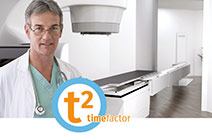
ESTRO 2016 in Turin: RPS is presented to the expert public
May 30, 2016
About 3000 visitors at the European Society for Radiotherapy and Oncology (ESTRO)
ESTRO 2016 in Turin: RPS is presented to the expert public
The Radiotherapy Patient System RPS from the German company gKteso located in Bobingen was presented at the 35th ESTRO in late April to around 3,000 expert visitors to Turin from around the world. In addition to numerous workshops and lectures about radiotherapy and oncology, ESTRO provides the opportunity for selected manufacturers to present their innovations. Interest in the Radiotherapy Patient system was great: the possibilities of the automatic treatment couch which can be moved in 6 dimensions sets new standards for radiation treatment.
In the basic version, the Radiotherapy Patient System is simply called “RPS base”. However this simple name belies the sophisticated technology that is “Made in Germany”: With six degrees of freedom (6 dof), patients up to a weight of 250 kilograms can be moved around on the treatment couch. This allows RPS to safeguard the quality of modern radiotherapy systems and efficiently enhance their technology: Cameras and tracking systems, as well as lasers, that are already integrated capture the patient’s position on the radiotherapy platform. The secured patient can now be moved to the ideal position with the RPS, with millimeter accuracy and flexibly in all six axes. This accuracy is especially important when a patient’s head is being treated with high-precision doses of radiation. This is because the more precisely the tumor cells are targeted, the better the chances of cure and the lower the side effects.
Cost advantage for hospitals and radiation treatment centers: Maximum utilization thanks to RPS extended
The Radiotherapy Patient System RPS extended is at the heart of a modern radiation therapy center. It allows the parallel preparation and treatment of three patients simultaneously. In separate rooms, patients can be prepared for radiation treatment on the treatment platform. This includes the alignment of the patient as well as any necessary measures for immobilization. This process requires great care and precision, so that during subsequent radiation therapy the tumors are irradiated as much as possible and healthy tissue is spared. Important time which so far has forced the linear accelerator to cease operation.
RPS extended ensures that the radiation therapy system is used optimally: A mobile arm transports the treatment platform with the prepared patient in a smooth manner right under the linear accelerator and hands the patient over to the RPS. Equipped with six degrees of freedom, RPS moves patients into the calculated position for radiation treatment. With the aid of additional camera systems or tracking methods, the patient’s respiratory movements or peristalsis can be detected by the Radiotherapy Patient System and compensated. And while the radiation treatment is taking place, two further patients can be already prepared.
RPS base also modernizes older systems
While the RPS extended is intended especially for the construction of new hospitals and radiation therapy centers, the expert visitors to ESTRO were interested in the basic variant, RPS base. This is so older radiation therapy systems can be modernized and improved. Thus, the RPS, due to its six-dimensional mobility, compensates for deficient set-up options of older systems. The integrated RFID reader (radio frequency identification) improves safety by comparing the patient’s position with the pre-defined target data. “ESTRO has brought our innovative RPS into contact with the people who work daily in the field of radiotherapy. The great interest and many contacts have shown us that RPS can further improve safety and comfort for patients. We see clearly the future after the expert discussions in modern radiation therapy centers, which bring several partners together to create cost advantages. Here, the RPS extended will play an important role in the efficient use of the linear accelerator while improving the procedure for the patient”, concluded Guido Kübler.
Radiotherapy Patient System – the advantages at a glance
– Improved patient comfort as a result of a low entry height, which can be also be managed by wheelchair users.
– Improved patient safety through reliable and reproducible storing of the individual patient positioning and of all relevant data.
– Integrated RFID reader (radio frequency identification): Data on the patient’s wristband or from fixing apparatus can be read in and transferred, safeguarding both treatment and documentation.
detects the position of the patient and transports them when deviations occur to
the pre-defined location
– In combination with optical methods or tracking of fiducial markers, body movements such as breathing or peristalsis can be compensated.
